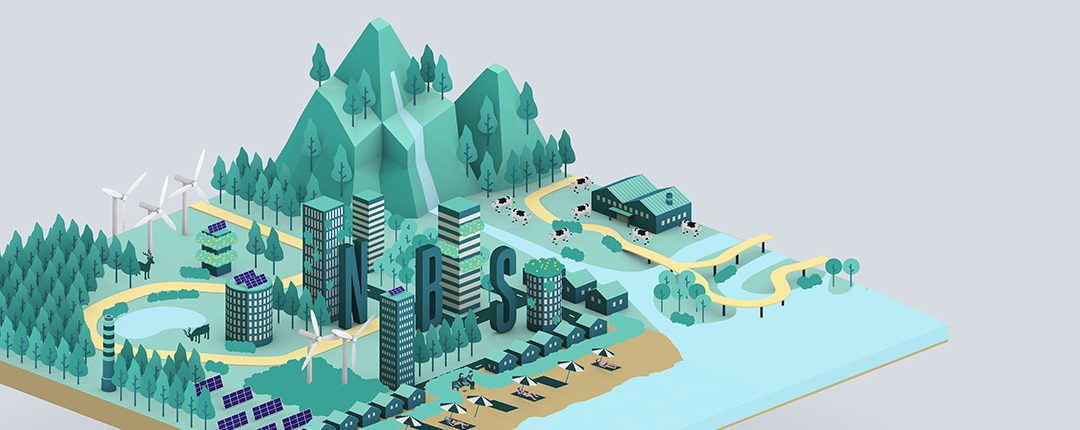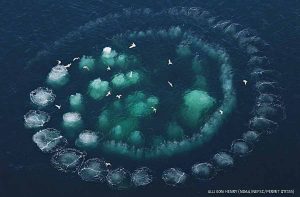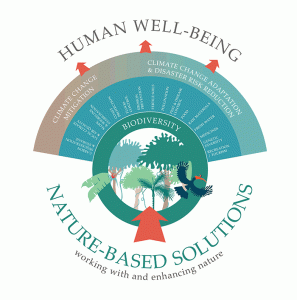Imagine being a Humpback whale. You are roughly the size of a school bus and requiring a tremendous about of energy to keep you alive. Lucky for you, you live in waters that house schools of small crustaceans called krill, which is your primary diet. Given that they are very small in comparison to your colossal self, they are quite nifty in escaping your gape. You on the other hand cannot afford to scoop large mouthfuls of seawater only to eat a dismal ration of krill goodness.
To get a good mouthful, you need to entrap a decent amount of your prey within a small range. Once you are sure that they have no means of escape, you can then lunge at the trapped mass with your mouth open. But how do you exactly do that? To create a trap, you move around in tight circles and usually partnering up with another whale, you blow bubbles through your blowhole. You start from a good depth and spiral upwards blowing bubbles from below to make a series of shrinking circular traps that act as a net made of bubbles. By doing so you limit the school of krill gradually into a tight space. Once you have concentrated enough bounty for you and your partner, you are through to feed.
“How do you do it though?”
But did you ever stop to think how; being a 14 to 16 m long and roughly 30-ton behemoth, are you able to swim around in such tight circles? First, to have a good turnability, you need a greater lift force acting sideways. Second, to generate a good amount of lift force, you need to increase the angle your pair of flippers make with the stream of water that is flowing towards them. But there is a limit to how much you can tilt a wing or a flipper to create lift. Beyond this, the lift force created drops due to increased drag, which is known as stall.
You have an interesting looking pair of flippers at your disposal to delay the stall and create a greater maximum lift force. The lead edge of your flipper consists of bumps knowns as tubercles. These funnel the water passing over it through the troughs in between. Thus making it more efficient than smooth flippers in making greater angles with much less drag. This gives a greater maximum lift before hitting stall. This is particularly interesting to us humans since we always had a battle with unwelcomed drag and sudden stalls.
Nature-Based Solutions (NBS)
This design of sinusoidal lead edges is adapted in wind turbines to create more wind energy, which is converted into a greater electrical energy compared to smooth-edged blades. Airplane wings, surfboards, and fan blades also apply this concept. Needless to say, one of the many occasions where we find nature holding astonishingly efficient solutions for our problems.
Mankind faces a great deal of challenges. Creating a sustainable development for all humanity while addressing global climate change, biodiversity loss, land degradation and so many other issues is of paramount importance to them all. Once again, the solution is in nature. The idea here is to incorporate features and processes that are inspired or supported by nature into civics, landscapes, seascapes, etc. We identify this as Nature-Based Solutions or NBS.
With the help of local knowledge the inhabitants have of their surroundings, we can obtain NBS. The results are always benefitting the locality. To name a few, it provides more job opportunities, increases the resilience of the area to the natural disasters that it is most prone to, and boosts water and food security. NBS sustainably solves many socio-environmental problems while protecting and supporting local biodiversity to a decent extent. Moreover, it’s much more cost-effective than engineered solutions.
Mangroves as an example
A nature-based solution for coastal erosion and the effects of changing sea levels are mangroves. The ability of mangroves to act as a buffer prevents flooding during hurricanes, storms and also evidently reduced the impact of the 2004 tsunami in its vicinity. In addition to providing costal protection, mangroves are excellent at sequestering carbon. These are also breeding grounds for many species of fish and shrimps, providing jobs and food security.
Mangrove forests in the North of Srilanka suffered massively due to the civil war and in the West due to shrimp farming, a highly lucrative business. Also, cutting down plants for charcoal and clearance for construction sites were contributing reasons. This led to its eventual recession which aggravated the effects of inland flooding due to monsoon rains.
Sri Lankan Mangrove Conservation Project
Led by the government, Seacology and Sudeesa with the participation of 1500 small communities living close to mangroves, this project was aimed to protect the remaining 8,815 hectares of mangroves and to replant 3,885 hectares of mangrove forests that have been cut down. The essence of this is to cut down the pressure human exploitation has on this ecosystem. This is done by providing alternative jobs and microloans to families, especially the womenfolk. Also, it helps the gradual buildup of genes, species, and functional richness through replanting. Overall, this makes the ecosystem more healthy, and the healthy ecosystem functions as a better buffer reducing the damages caused by flooding.
Grey, Green, and Blue: Nature-Based Solutions and New Generation Infrastructure
It is now unmistakable that green and blue components (such as forests, mangroves, flood plains, rivers, etc.) must be allowed a bigger part in addition to the traditional grey infrastructure as far as sustainability and security is in concern. Also, integrated grey and green infrastructure are proposed to incorporate more vegetation around areas that are considered “grey”, such as bridges, roads, etc. The idea is to harness thriving ecosystems to produce tangible benefits.
The Answer Lies in Nature
This year, we commemorate the International Day for Biological Diversity under the slogan “Our solutions are in nature”. Regardless of how far we have progressed in terms of our living, technology, and knowledge from our early ancestors, we still rely on ecosystems around us and the diverse lifeform it holds. The future ahead isn’t just written for us humans alone. It is shared with all living beings alike to bring balance and prosperity. Let’s take this day to remind ourselves that we are a part of nature and we must act our part to safeguard it from our irresponsibilities.
References:
01. https://earthsky.org/earth/humpback-whales-make-bubble-nets-with-beauty-and-precision
02. https://www.acsonline.org/humpback-whale
03. https://www.technologyreview.com/2008/03/06/221447/whale-inspired-wind-turbines/
04. https://www.grc.nasa.gov/WWW/K-12/airplane/incline.html
05. http://www.eng.fsu.edu/~dommelen/research/airfoil/airfoil.html
06. https://royalsocietypublishing.org/doi/10.1098/rstb.2019.0120#d3e1228
07. https://www.seacology.org/project/sri-lanka-mangrove-conservation-project/
Image Courtesies:
01.Featured image: https://bit.ly/3g8QCGB
02.Image 1: https://bit.ly/3bRvi51
03.Image 2: https://bit.ly/36m1gVO
04.Image 3: https://bit.ly/2ZqVdy8




